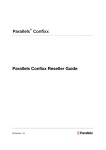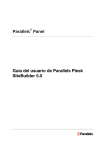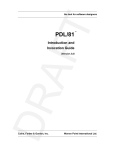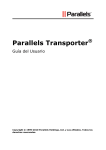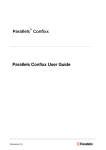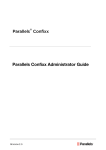Download Parallels Welder 8.4 User's Manual
Transcript
® Parallels Plesk Control Panel Copyright Notice ISBN: N/A Parallels 660 SW 39th Street Suite 205 Renton, Washington 98057 USA Phone: +1 (425) 282 6400 Fax: +1 (425) 282 6444 © Copyright 1999-2008, Parallels, Inc. All rights reserved Distribution of this work or derivative of this work in any form is prohibited unless prior written permission is obtained from the copyright holder. Patented technology protected by U.S.Patents 7,328,225; 7,325,017; 7,293,033; 7,099,948; 7,076,633. Patents pending in the U.S. Product and service names mentioned herein are the trademarks of their respective owners. Contents Preface 4 About This Guide ........................................................................................................................... 4 Who Should Read This Guide ....................................................................................................... 4 Typographical Conventions ........................................................................................................... 5 Feedback ....................................................................................................................................... 5 Localization Overview 6 Locale Components....................................................................................................................... 8 Language Pack Content ................................................................................................................ 9 Creating And Installing LP 11 Obtaining Default LP ................................................................................................................... 11 Translating LP Files ..................................................................................................................... 12 Translating GUI and Contextual Help Messages .............................................................. 12 Translating Online Help ..................................................................................................... 16 Compiling LP ............................................................................................................................... 18 Installing LP ................................................................................................................................. 19 Locale Codes 20 4 Preface Preface In this section: About This Guide............................................................................................... 4 Who Should Read This Guide ........................................................................... 4 Typographical Conventions ............................................................................... 5 Feedback .......................................................................................................... 5 About This Guide This document is a guide to translating Plesk for Linux/Unix interface and online help to languages other than those released by Parallels. Chapter 2, "Localization Overview" gives an idea of localizing a software product, explains such terms used in the document as locale and language pack, and focuses on the localization capabilities of Plesk in detail. Chapter 3, "Creating And Installing LP" provides guidelines, instructions and recommendations on creating a Plesk language pack and installing it to Plesk. The Appendix "Locale Codes" lists names of the locales supported by Plesk. Who Should Read This Guide This guide is intended for those willing to create custom language packs, i.e., to translate Plesk interface and online help to languages other than officially supported by Parallels. Preface 5 Typographical Conventions Before you start using this guide, it is important to understand the documentation conventions used in it. The following kinds of formatting in the text identify special information. Formatting convention Type of Information Example Special Bold Items you must select, such as menu options, command buttons, or items in a list. Go to the System tab. Titles of chapters, sections, and subsections. Read the Basic Administration chapter. Italics Used to emphasize the importance of a point, to introduce a term or to designate a command line placeholder, which is to be replaced with a real name or value. The system supports the so called wildcard character search. Monospace The names of commands, files, and directories. Preformatted On-screen computer output in your command-line sessions; source code in XML, C++, or other programming languages. The license file is located in the http://docs/common/license s directory. # ls –al /files total 14470 Preformatted Bold What you type, contrasted with on-screen computer output. # cd /root/rpms/php CAPITALS Names of keys on the keyboard. SHIFT, CTRL, ALT KEY+KEY Key combinations for which the user must press and hold down one key and then press another. CTRL+P, ALT+F4 Feedback If you have found a mistake in this guide, or if you have suggestions or ideas on how to improve this guide, please send your feedback using the online form at http://www.parallels.com/en/support/usersdoc/. Please include in your report the guide's title, chapter and section titles, and the fragment of text in which you have found an error. CHAPTER 1 Localization Overview Since Plesk is a web application, a single instance may simultaneously target an international, multi-language audience owing to the possibility of localization. Localization means a process of adapting software for a particular country or region, which is, generally speaking, translating Plesk user's environment to a language spoken in the country or region. A subset of Plesk user's environment adjusted to a particular language and culture is called locale. The Locale Components (on page 8) section answers what substitutes a Plesk locale. On the implementation level, a particular locale is represented by the corresponding language pack (LP). Language pack is an installable file containing all the resource files and processing instructions necessary for installing a particular locale to an existing Plesk instance. In other words, LP is a packed set of files containing all the language-related data that define the appearance of a particular user environment component. The Language Pack Content (on page 9) section focuses on what files are included to an LP, how the files must be structured, and shows how these files are related to locale components. Plesk locale and language pack names follow the RFC 1766 standard in the format "<languagecode2>-<country/regioncode2>", where <languagecode2> is a lower-case two-letter code derived from ISO 639-1 and <country/regioncode2> is an upper-case two-letter code derived from ISO 3166. For example, U.S. English locale is named "enUS". To see a list of locale names supported by Plesk, refer to the Appendix Locale Codes (on page 20). Note: Plesk supports an arbitrary number of locales (depends on the purchased Plesk license). A particular locale can be represented by only one LP, that is, you cannot install to a Plesk, for example, two different en-US language packs. By default, Plesk is shipped with only U.S. English language pack. Parallels also releases LP's for eight additional languages, which are: German (de-DE) French (fr-FR) Spanish (es-ES) Italian (it-IT) Russian (ru-RU) Japanese (ja-JP) Simplified Chinese (zh-CN) Traditional Chinese (zh-TW) Localization Overview These additional language packs for the latest Plesk version are available at the Language Support page (http://www.parallels.com/en/products/plesk/lp/) of the Parallels official Web Site. To obtain an additional LP for the previous Plesk versions, browse to Previous Versions in the left menu, select the required version and go to the corresponding Language Support page. This Plesk Localization Kit is designed to allow third-party developers to create their own localizations for Plesk. Note: To install and use additional LPs, be sure to have a Plesk license key allowing multi-language support with a required number of language packs. In this chapter: Locale Components .......................................................................................... 8 Language Pack Content .................................................................................... 9 7 8 Localization Overview Locale Components We distinguish the following three components in each Plesk locale: 1 Interface Messages. Include the following: All textual elements of graphical user interface (except for the contextual help tips), namely, names of the buttons, icons, links, checkboxes, lists, options, list items, and so on All alert, warning, error, progress and operation-result messages 2 Contextual Help. A set of context-dependent tips shown at the bottom of navigation pane. Contextual help messages say in brief either what the current Plesk page is designed for, or, if a mouse pointer is placed over a GUI control (button, icon, list heading, etc.), what the meaning of the control is. 3 Online Help. A Plesk user's guide which opens upon clicking Help in navigation pane and displays the content relevant to the current Plesk page. Figure 1: Plesk locale components Each of the components is defined by a particular file or set of files within a language pack. Localization Overview Language Pack Content All locale-defining files are specifically structured within a language pack, so that when the LP is being installed, the locale files are correctly built in the Plesk directories structure. LP files and folders are structured as shown below (plib/ and htdocs/ directories are located at the LP root). plib/ serves as a container for the lower-level directory locales/ serves as a container for the lower-level directory <locale>/ conhelp_ <locale>.php messages_ <locale>.php htdocs/ serves as a container for the files defining GUI messages and contextual help. Must be named according to the locale implemented by the LP. For example, in case of the U.S. English, its name is en-US. contains strings that define contextual help tips: What contextual help text is shown when a mouse points at a particular page control. Must be named according to the locale implemented by the LP. For example, in case of the U.S. English, its name is conhelp_en-US.php. contains strings that define interface messages: What interface message is shown at what Plesk interface location. Must be named according to the locale implemented by the LP. For example, in case of the U.S. English, its name is messages_en-US.php. serves as a container for the lower-level directory locales/ serves as a container for the lower-level directory <locale>/ serves as a container for htm/html files defining a particular locale. Must be named according to the locale implemented by the LP. For example, in case of the U.S. English, its name is en-US. license.html contains the text of Parallels. End-User License Agreement shown to Plesk Administrator at his first login to the control panel help/ contains files composing online help addressed to Plesk Administrator; serves as a container for lower-level directories cl/ contains files composing online help addressed to Plesk Client 9 10 Localization Overview dl_usr/ contains files composing online help addressed to Plesk Domain Administrator ml_usr/ contains files composing online help addressed to Plesk Mail User For the detailed information on files composing online help, refer to the Translating Online Help (on page 12) section. CHAPTER 2 Creating And Installing LP In brief, to create a language pack, you should do the following: 1 Obtain the default – en-US – language pack sources. 2 Translate the source files content to a required language. 3 Compile your resulting files to a new language pack. Refer to the following sub-sections for the detailed information on performing each of the steps. In this chapter: Obtaining Default LP ......................................................................................... 11 Translating LP Files........................................................................................... 12 Compiling LP ..................................................................................................... 18 Installing LP....................................................................................................... 19 Obtaining Default LP There are two ways to obtain default Plesk LP source files: 1. Taking the files downloaded with this Localization Kit (current version of Plesk) 2. Taking LP source files from a particular Plesk instance for which you want to create an LP To take the LP sources from a Plesk instance: 1 Upload the std_lp.tar.gz archive downloaded with this Localization Kit to the server where the required version of Plesk is installed, and unpack the archive. 2 Run the get_orig_locale utility with power user privileges. For example, when logged in as root: [root@localhost std]# ./get_orig_locale.sh The utility creates directory orig_locale.en-US/ in your current directory, and copies the default LP's sources from Plesk directories to it. 12 Creating And Installing LP Translating LP Files Once you obtained LP sources, the next step is to actually modify interface and contextual help messages, and online help texts. Generally speaking, you have two options when creating your language pack: creating a "partial" LP that localizes only the GUI part of the Plesk user's environment (which excludes online help system) creating a complete LP that localizes the whole Plesk user's environment (which includes online help system) The following sub-sections explain how the LP source files are organized, and provide recommendations that can be useful when translating the files. In this section: Translating GUI and Contextual Help Messages ............................................... 12 Translating Online Help ..................................................................................... 16 Translating GUI and Contextual Help Messages In this section: Files Structure ................................................................................................... 12 Translation Tips................................................................................................. 13 Files Structure Files messages_<locale>.php and conhelp_<locale>.php have a simple structure presenting an associative array made up of records like '<localization_key>' => '<message>' where <localization_key> uniquely identifies a Plesk GUI item <message> is a text in a human language which describes a particular Plesk GUI item, appearing as either a GUI or a contextual help text Creating And Installing LP 13 To adjust these files so that the Plesk GUI was displayed to users in a particular language, translate all string parts containing messages (<message>), leaving localization keys as they are. Important: Do not translate any of the localization keys. Plesk uses localization keys to link a particular GUI item with the corresponding message, so if you change a key in an LP file, the original key will be displayed in Plesk instead of the corresponding message. Translation Tips For editing locale-defining PHP files, we recommend using a text editor which supports highlighting syntax. Using such editors not only makes the translating more comfortable than when using those displaying just plain text, but also, what's more important, helps you detect the file corruption if you change the array syntax. Note: Use editor that supports editing texts in UTF-8. There is a number of recommendations that might be useful when translating these files, specifically, concerning PHP array syntax, message variables, HTML entities, and special characters. Important: Do not change the files encoding: It must be UTF-8. Otherwise, the messages you've translated may be displayed incorrectly. Array syntax # It is important that commas at the end of each string were left where they are. Otherwise, the PHP array will be corrupt and, when using such language pack, Plesk GUI will display pure localization keys instead of the correct messages. # What else can corrupt the array is mistakes in using quotes. To avoid such mistakes, follow the rules below. 1. If a message text does not contain any quotes, enclose the text with either single or double quotes. 2. If a message text contains at least one single quote or apostrophe: precede each quote with backslash: 'b_add_ip_for_clients' => 'Add IP address to client\'s pools.', or enclose the message with double quotes: 'b_add_ip_for_clients' => "Add IP address to client's pools.", 14 Creating And Installing LP 3. If a message text contains at least one double quote: precede each quote with backslash: 'odbc__mysql_option' => "Options that specify how MyODBC should work. See <a href=\"http://dev.mysql.com/doc/mysql/en/Connection_parameters.html\"> http://dev.mysql.com/doc/mysql/en/Connection_parameters.html</a>", or enclose the message with single quotes: 'odbc__mysql_option' => 'Options that specify how MyODBC should work. See <a href="http://dev.mysql.com/doc/mysql/en/Connection_parameters.html">ht tp://dev.mysql.com/doc/mysql/en/Connection_parameters.html</a>', Variables When translating Plesk interface and contextual help messages, pay special attention to the messages containing variables: Leave variables as they are, do not translate them. Translate the other text of a message carefully, considering a variable meaning and how the variable value will be embedded to the whole message text in Plesk interface. The following types of variables are used: 1 $PROD_NAME - replaces the nomination of the Plesk instance. For example, if we have Plesk 8.0 for Unix installed, and the file messages_enUS.php contains the string 'license__you_should_accept' => "In order to use $PROD_NAME you should agree to the terms of this license.", the corresponding message in the Plesk GUI looks as In order to use Plesk 8.0 for Unix you should agree to the terms of this license. 2 %%<variable-name>%% - variables of this type are used in messages_[locale].php files. For example, if the IP address is 192.0.2.68, the client name is John Doe, and the file messages_en-US.php contains the string 'ui__client/domain/properties__client_ip_address_was_assigned ' => 'The IP address %%ip_address%% was assigned to %%client_name%%.', then the corresponding message in Plesk GUI looks as The IP address 192.0.2.68 was assigned to John Doe. Creating And Installing LP 3 15 %1, %2, etc. - this type is used in messages_[locale].php files. Such variables may replace almost everything: titles of Plesk objects (Domain, Client, IP, etc.), domain, client and other Plesk objects names, error messages, and so on, – in each string, the meaning of a particular variable of such type depends on the context. The variable value is dynamically set by Plesk when it displays the message in its GUI. The table below gives an idea of how to understand messages with these variables. String Variable Meaning Message Examples 'clist__info' => '%4 %1 total', %4 - the number of items in a list 100 Domains total %1 - the Plesk object 30 Clients total 2 Databases total '__client_with_login_name_a %1 - Plesk client login lready_exists' => "Client with login name \"%1\" already exists.", Client with login name "johndoe" already exists. '__domain_resolves_to_anoth %1 - IP address to er_ip' => "The domain which a domain resolves to another IP resolves address (%1). Please correct DNS settings.", The domain resolves to another IP address (10.0.0.4). Please correct DNS settings. '__unable_update_cl_data' %1 - A phrase stating => "Unable to update client why updating a client data: %1", account is impossible. Unable to update client data: Client with login name "johndoe" exists. 16 Creating And Installing LP HTML Entities; Special Characters Do not translate HTML entities for example, <, > used for defining "<" and ">" symbols special characters for example, \n used for defining a new line Translating Online Help In this section: Files Structure ................................................................................................... 16 Translation Tips................................................................................................. 18 Files Structure Online help is presented by 4 sets of files, each designed for displaying to a particular Plesk user and located at a specific folder within LP: Administrator (htdocs/locales/<locale>/help/) Client (htdocs/locales/<locale>/help/cl/) Domain Administrator (htdocs/locales/<locale>/help/dl_usr/) Mail User (htdocs/locales/<locale>/help/ml_usr/) 4 different online help systems exist due to the difference in Plesk functionality available to each type of Plesk users. In spite of this difference in content, the online help systems are the same in the view of their implementation: All of them are Plesk User's guides compiled of the specific files building particular structural elements of the guides. Creating And Installing LP 17 To translate an online help system, you should modify the following files: 1 numerous *.htm files: 1. <number>.htm (e.g., 33243.htm) pages containing the online help contents, displayed in the main (content) frame of the online help window 2. toc.htm, toc<number>.htm (e.g., toc246135.htm) pages containing different states of the Contents tree, displayed in the left frame of the online help window 2 *.gif files: *.gif images used as navigation elements: Top of page, Prev, Next, Locate Page, and Print 3 dhtml_search.js java script implementing the mechanism of search through the guide This figure shows the structural elements of the online help system defined by the files listed above. Figure 2: Online help structural elements 18 Creating And Installing LP Translation Tips For editing the files that build Plesk online help system, we recommend using a WYSIWYG HTML editor which supports working with files in UTF-8. Using such editor makes the process of translation more comfortable because it lets you concentrate on modifying the help content without the necessity of separating it from the HTML syntax; prevents you from modifying anything besides the help content, which guarantees that the files will not be corrupted somehow. Important: Do not change the files encoding: It must be UTF-8. Otherwise, the texts you translated may be displayed incorrectly. Compiling LP Once you translated the locale-defining files to a required language, you are ready to compile them to a language pack, which will be easily installed to Plesk afterwards. To compile an LP: 1 Unpack the std_lp.tgz archive downloaded with this Localization Kit. 2 Go to the directory std/dist/ created during unpacking the archive on the previous step. 3 In the std/dist/, create the LP directories structure (for details, refer to the Language Pack Content (on page 9) section) assuming that std/dist/ is an LP root. Replace <locale> in directories names with the name of your language pack. For example, if making up a language pack for Dutch spoken in The Netherlands (nl-NL), the directories you create must be std/dist/plib/locales/nl-NL and std/dist/htdocs/locales/nl-NL. For the list of locale/LP names supported by Plesk, refer to the Locale Codes (on page 20) section. 4 Copy your translated LP files to the directories created on the previous step. Be sure to include to the std/dist/ directory all directories and files building an LP: Even if you are making a "partial" LP (only GUI and contextual help messages translated), include the default online help files and folders. Otherwise, your LP will not be compiled (in case when htdocs/... folders are missing), or no online help will be available after applying the LP (in case when files in the htdocs/.../ folders are missing). Creating And Installing LP 19 5 Change the names of LP files containing the locale name. For our example with Dutch LP (nl-NL), the following changes should be done: messages_en-US.php --> messages_nl-NL.php conhelp_en-US.php --> conhelp_nl-NL.php 6 Make std/ your current directory and run the make_lp_dist utility. Usage: make_lp_dist.sh <major-version.minor-version> <locale> Running the utility results in creating in the std/ directory an installable language pack with the name in format plesk_locale_<major-version.minorversion>_build<YYMMDD.HH>_<locale>_install.sh, where build<YYMMDD.HH> indicates the timestamp for the LP creation. For our example with Dutch LP for Plesk 8.1.1, the command compiling the LP is # ./make_lp_dist.sh 8.2 nl-NL and the resulting Dutch LP gets the name plesk_locale_8.2_build070710.14_nl-NL_install.sh. Installing LP To install an LP to Plesk: 1 Upload the LP self-installing file to the server with Plesk (the upload directory is not important). 2 Run the file. For example, # ./plesk_locale_8.1_build070206.14_nl-NL_install.sh After you receive from the system the message about successful installing of the LP, the LP you created and installed can be used in Plesk, it appears automatically in the list of installed language packs (Server > Interface Management > Locales) and becomes available for choosing in all Interface Preferences forms, and on the Plesk login screen. 20 Locale Codes Locale Codes Language - Country/Region Code Language - Country/Region Code Afrikaans af Icelandic is Afrikaans - South Africa af-ZA Icelandic - Iceland is-IS Albanian sq Indonesian id Albanian - Albania sq-AL Indonesian - Indonesia id-ID Arabic ar Italian it Arabic - Algeria ar-DZ Italian - Italy it-IT Arabic – Bahrain ar-BH Italian - Switzerland it-CH Arabic – Egypt ar-EG Japanese ja Arabic – Iraq ar-IQ Japanese - Japan ja-JP Arabic – Jordan ar-JO Kannada kn Arabic – Kuwait ar-KW Kannada - India kn-IN Arabic – Lebanon ar-LB Kazakh kk Arabic – Libya ar-LY Kazakh - Kazakhstan kk-KZ Arabic - Morocco ar-MA Korean ko Arabic - Oman ar-OM Korean - Korea ko-KR Arabic - Qatar ar-QA Kyrgyz ky Arabic - Saudi Arabia ar-SA Kyrgyz - Kyrgyzstan ky-KG Arabic - Syria ar-SY Latvian lv Arabic - Tunisia ar-TN Latvian - Latvia lv-LV Arabic - United Arab Emirates ar-AE Lithuanian lt Arabic - Yemen ar-YE Lithuanian - Lithuania lt-LT Armenian hy Macedonian mk Armenian - Armenia hy-AM Macedonian - Former Yugoslav Republic of Macedonia mk-MK Azeri az Malay ms Azeri - Azerbaijan az-AZ Malay - Brunei ms-BN Basque eu Malay - Malaysia ms-MY Basque - Basque eu-ES Marathi mr Belarusian be Marathi - India mr-IN Belarusian - Belarus be-BY Mongolian mn Bulgarian bg Mongolian - Mongolia mn-MN Locale Codes Language - Country/Region Code Language - Country/Region Code Bulgarian - Bulgaria bg-BG Norwegian no Catalan ca Norwegian (Bokmål) - Norway nb-NO Catalan - Spain ca-ES Norwegian (Nynorsk) - Norway nn-NO Chinese zh Polish pl Chinese - Hong Kong SAR zh-HK Polish - Poland pl-PL Chinese - Macao SAR zh-MO Portuguese pt Chinese - China (Simplified Chinese) zh-CN Portuguese - Brazil pt-BR Chinese - Singapore zh-SG Portuguese - Portugal pt-PT Chinese - Taiwan (Traditional Chinese) zh-TW Punjabi pa Croatian hr Punjabi - India pa-IN Croatian - Croatia hr-HR Romanian ro Czech cs Romanian - Romania ro-RO Czech - Czech Republic cs-CZ Russian ru Danish da Russian - Russia ru-RU Danish - Denmark da-DK Sanskrit sa Dutch nl Sanskrit - India sa-IN Dutch - Belgium nl-BE Serbian sr Dutch - The Netherlands nl-NL Serbian - Serbia sr-SP English en Slovak sk English - Australia en-AU Slovak - Slovakia sk-SK English - Belize en-BZ Slovenian sl English - Canada en-CA Slovenian - Slovenia sl-SI English - Caribbean en-CB Spanish es English - Ireland en-IE Spanish - Argentina es-AR English - Jamaica en-JM Spanish - Bolivia es-BO English - New Zealand en-NZ Spanish - Chile es-CL English - Philippines en-PH Spanish - Colombia es-CO English - South Africa en-ZA Spanish - Costa Rica es-CR English - Trinidad and Tobago en-TT Spanish - Dominican Republic es-DO English - United Kingdom en-GB Spanish - Ecuador es-EC English - United States en-US Spanish - El Salvador es-SV English - Zimbabwe en-ZW Spanish - Guatemala es-GT Estonian et Spanish - Honduras es-HN Estonian - Estonia et-EE Spanish - Mexico es-MX 21 22 Locale Codes Language - Country/Region Code Language - Country/Region Code Faroese fo Spanish - Nicaragua es-NI Faroese - Faroe Islands fo-FO Spanish - Panama es-PA Farsi fa Spanish - Paraguay es-PY Farsi - Iran fa-IR Spanish - Peru es-PE Finnish fi Spanish - Puerto Rico es-PR Finnish - Finland fi-FI Spanish - Spain es-ES French fr Spanish - Uruguay es-UY French - Belgium fr-BE Spanish - Venezuela es-VE French - Canada fr-CA Swahili sw French - France fr-FR Swahili - Kenya sw-KE French - Luxembourg fr-LU Swedish sv French - Monaco fr-MC Swedish - Finland sv-FI French - Switzerland fr-CH Swedish - Sweden sv-SE Galician gl Tamil ta Galician - Galician gl-ES Tamil - India ta-IN Georgian ka Tatar tt Georgian - Georgia ka-GE Tatar - Russia tt-RU German de Telugu te German - Austria de-AT Telugu - India te-IN German - Germany de-DE Thai th German - Liechtenstein de-LI Thai - Thailand th-TH German - Luxembourg de-LU Turkish tr German - Switzerland de-CH Turkish - Turkey tr-TR Greek el Ukrainian uk Greek - Greece el-GR Ukrainian - Ukraine uk-UA Gujarati gu Urdu ur Gujarati - India gu-IN Urdu - Pakistan ur-PK Hebrew he Uzbek uz Hebrew - Israel he-IL Uzbek - Uzbekistan uz-UZ Hindi hi Vietnamese vi Hindi - India hi-IN Vietnamese - Vietnam vi-VN Hungarian hu Hungarian - Hungary hu-HU

























